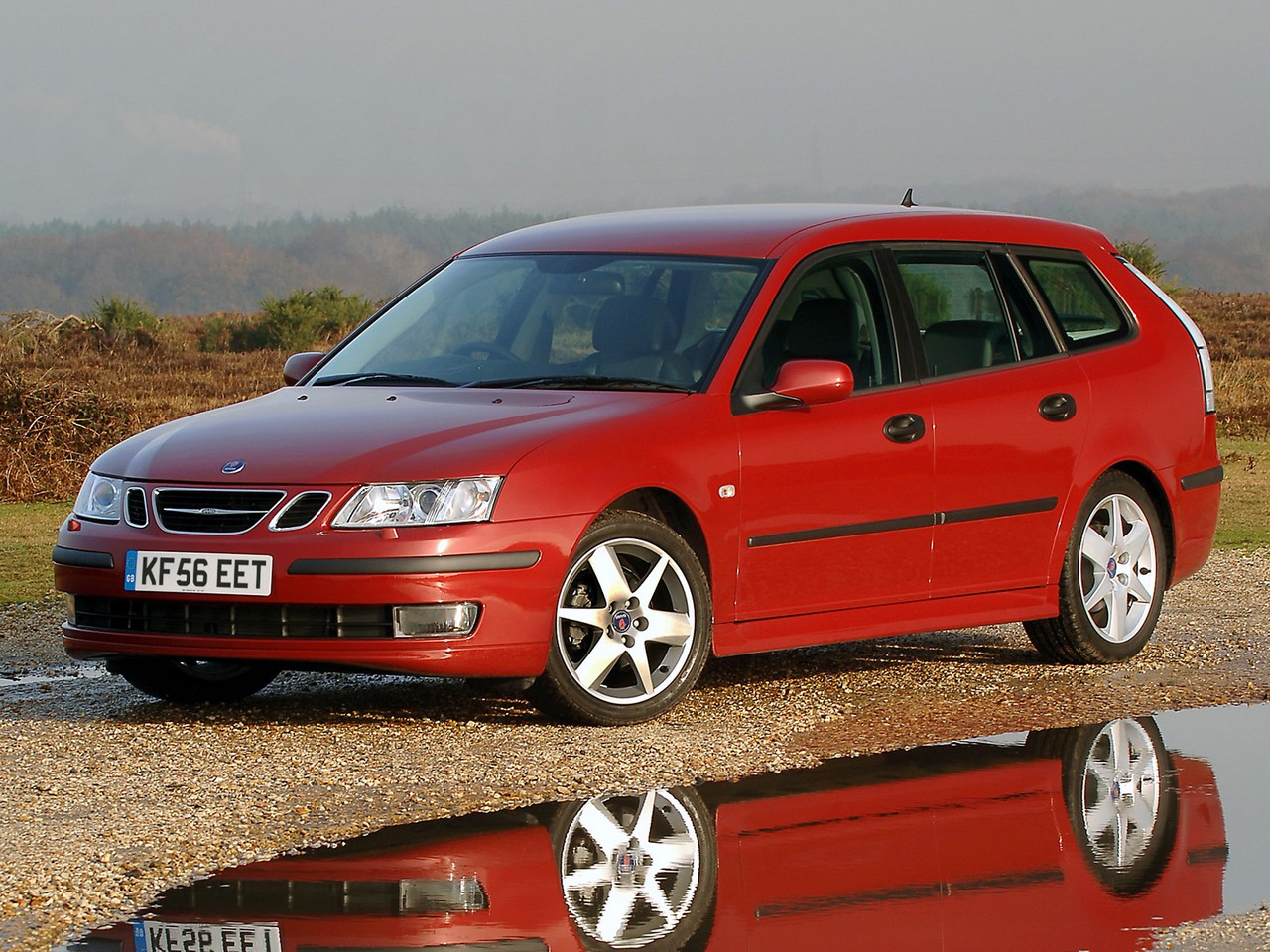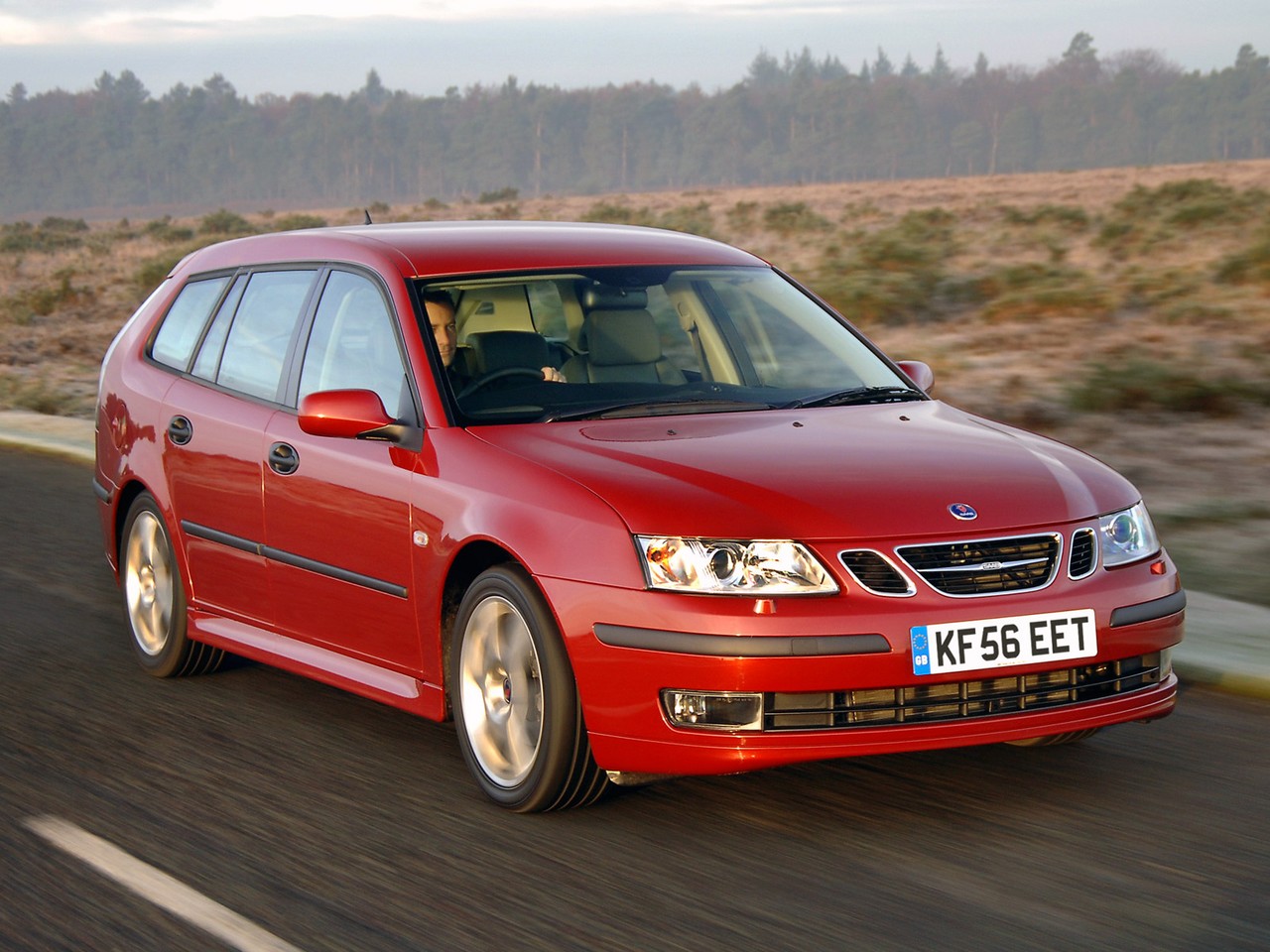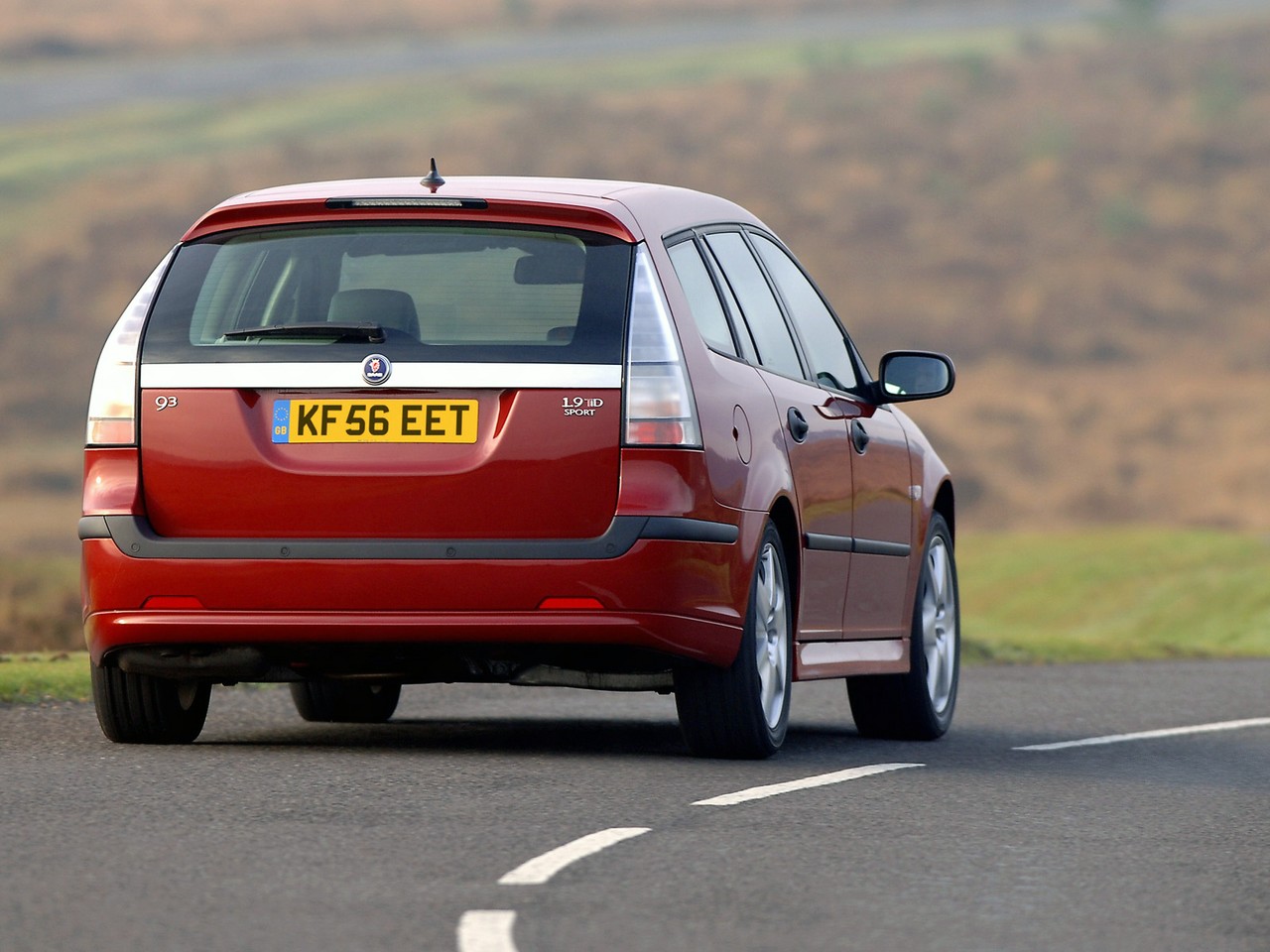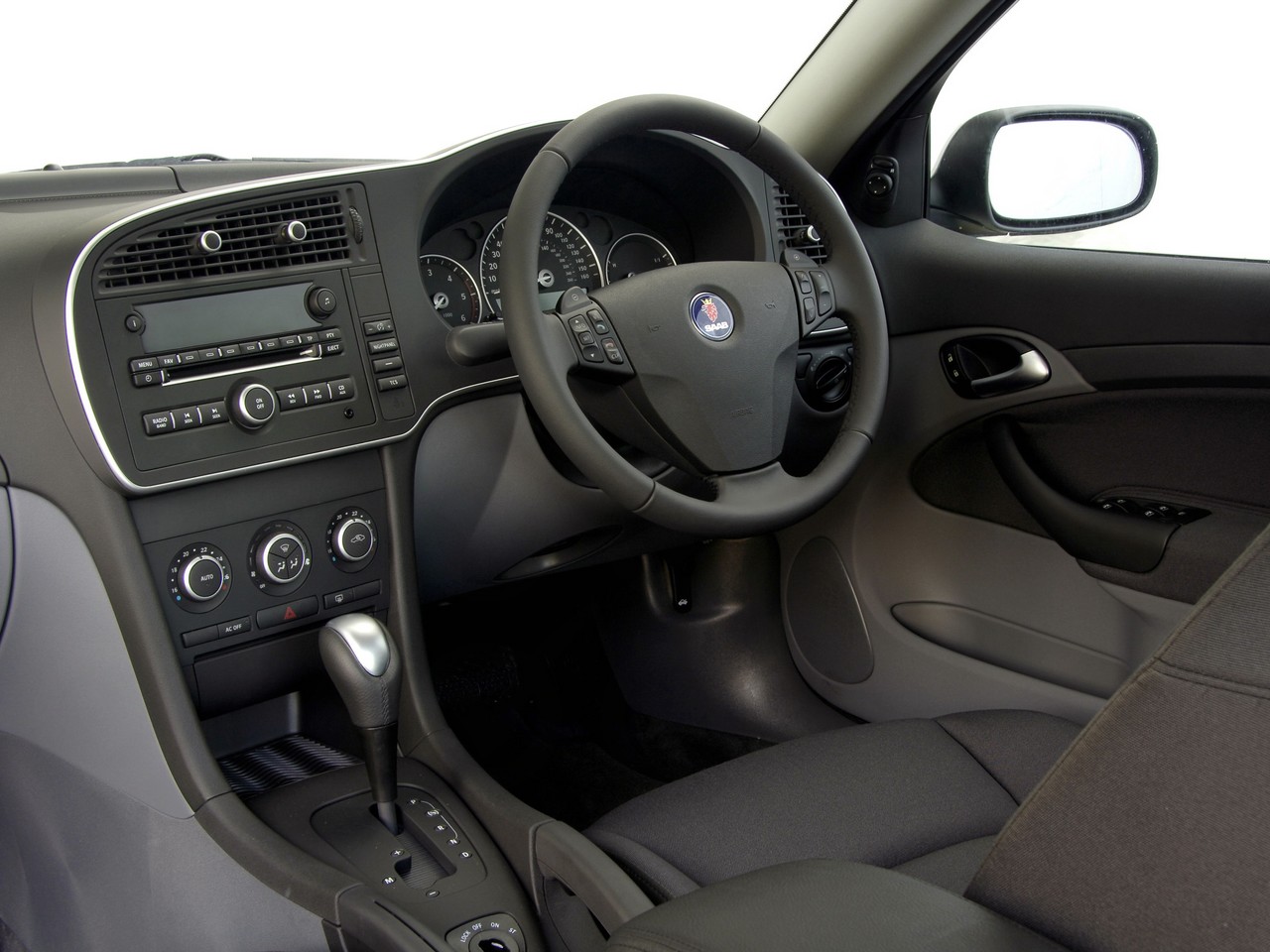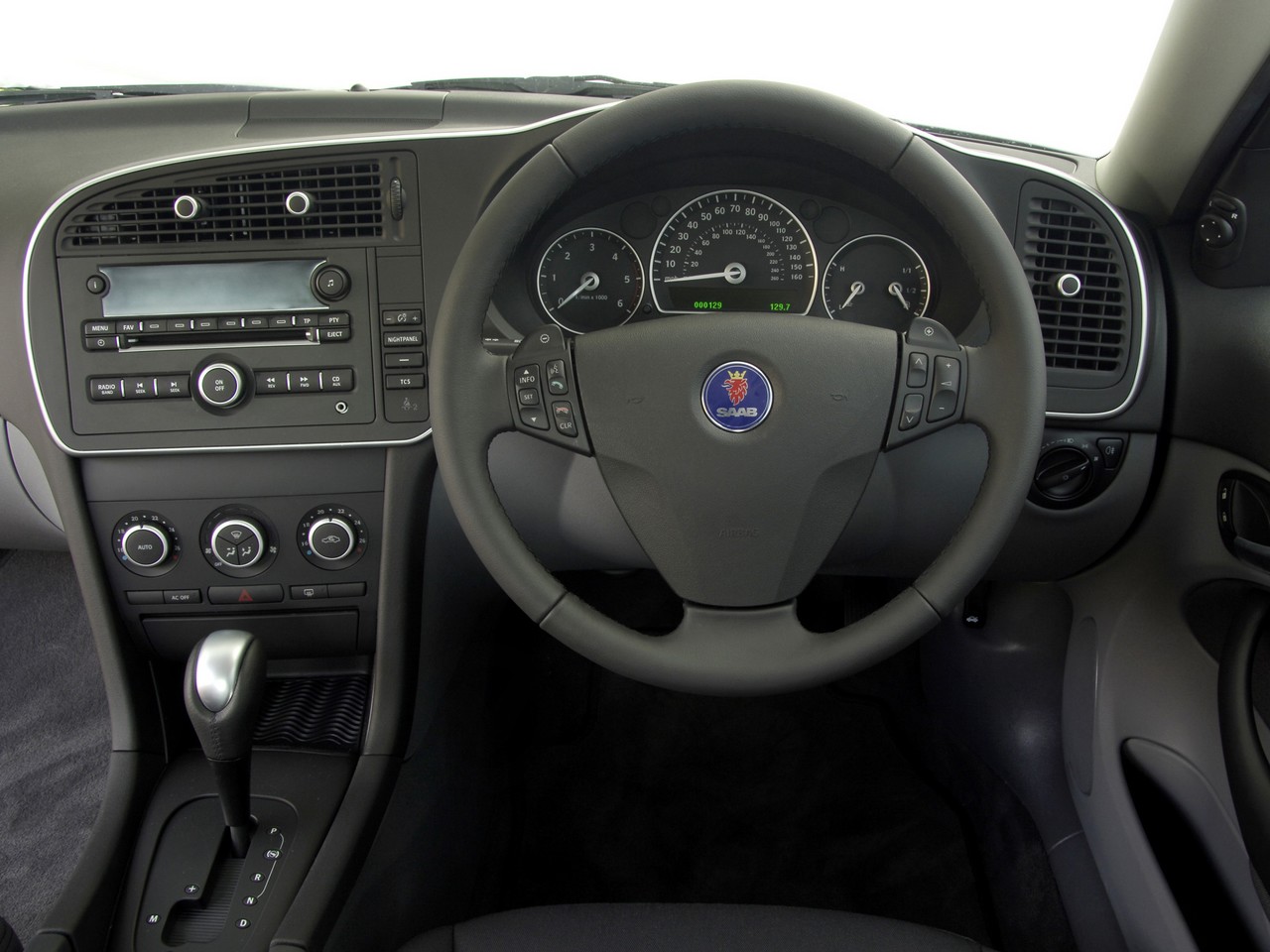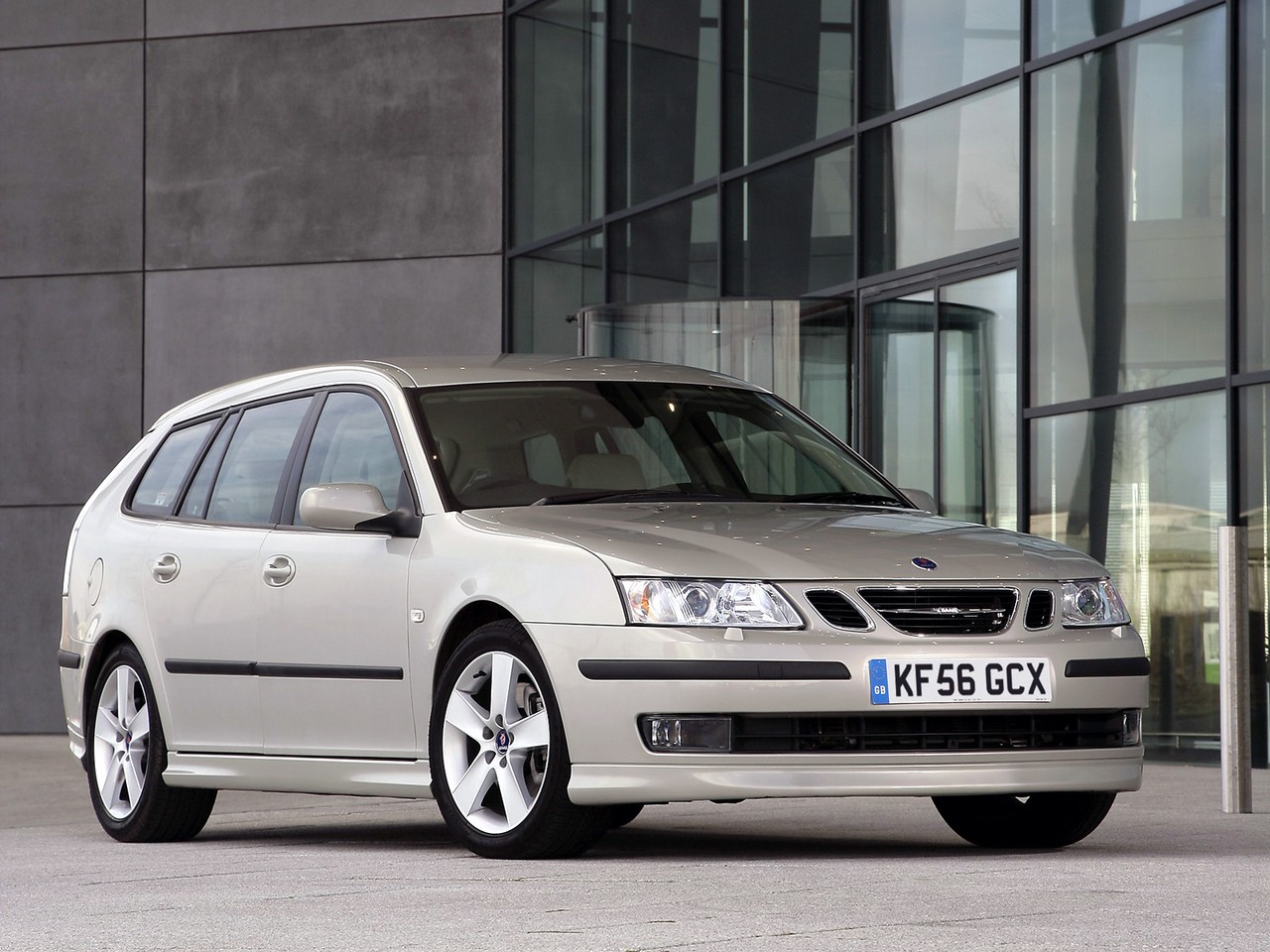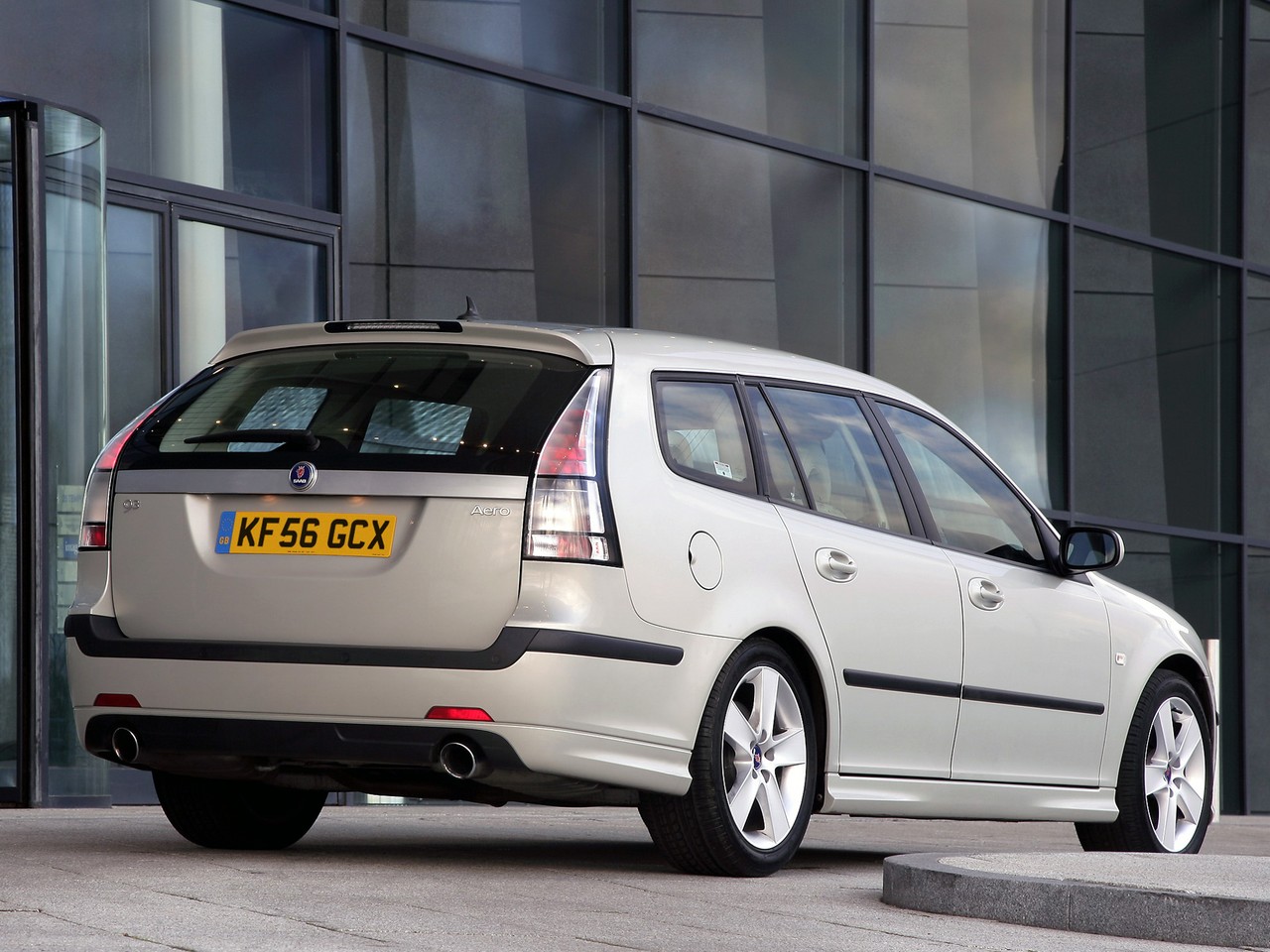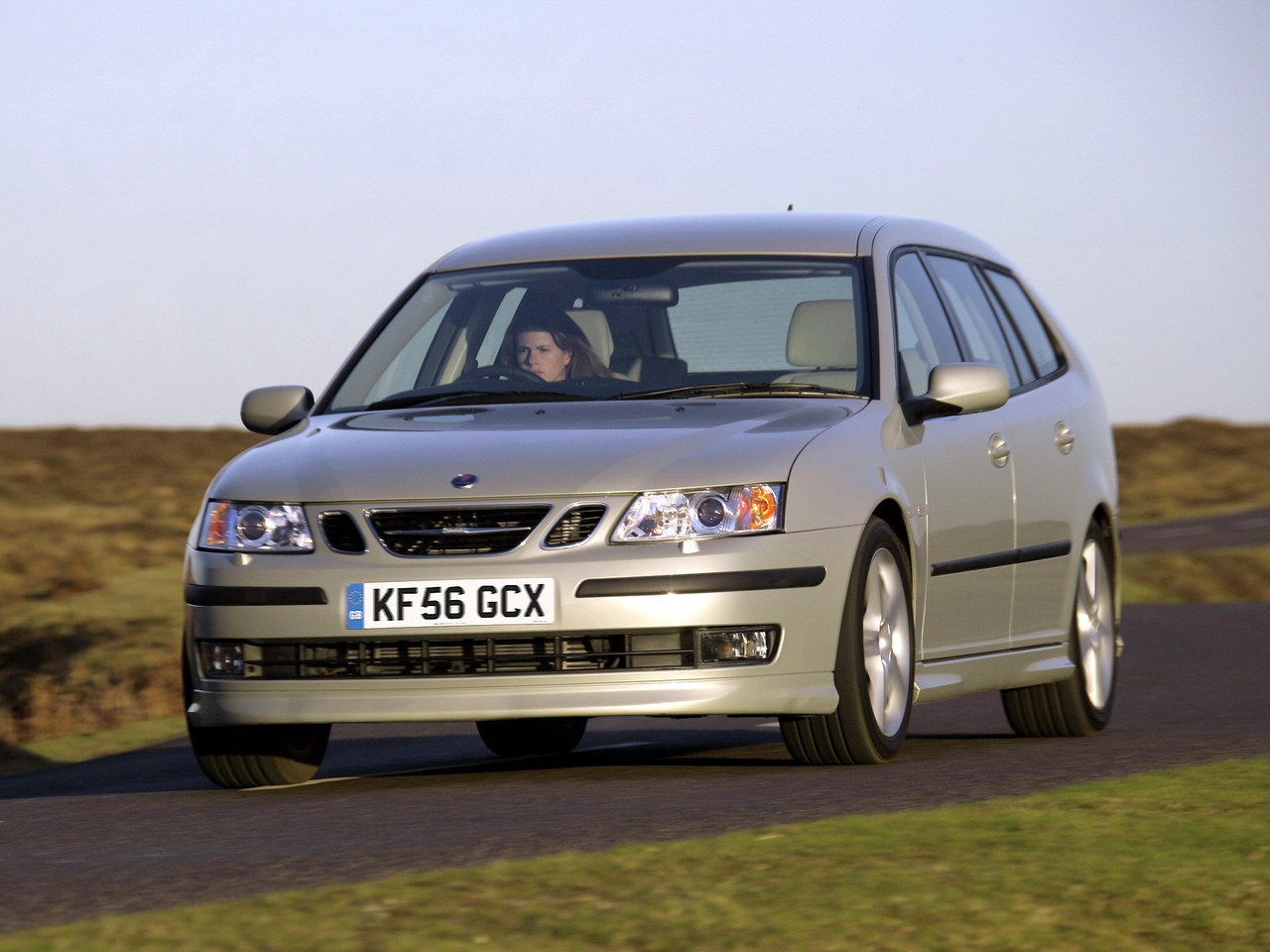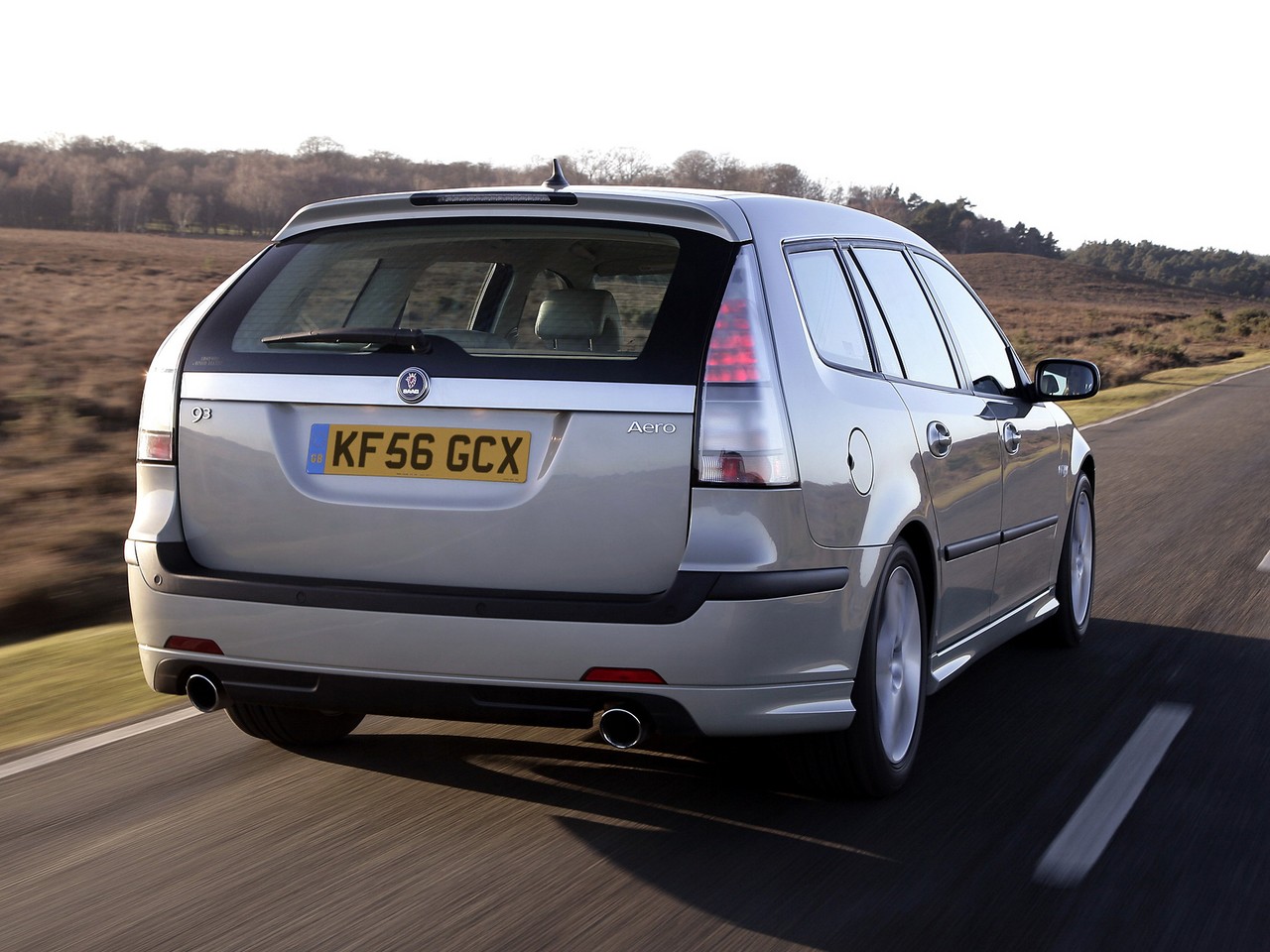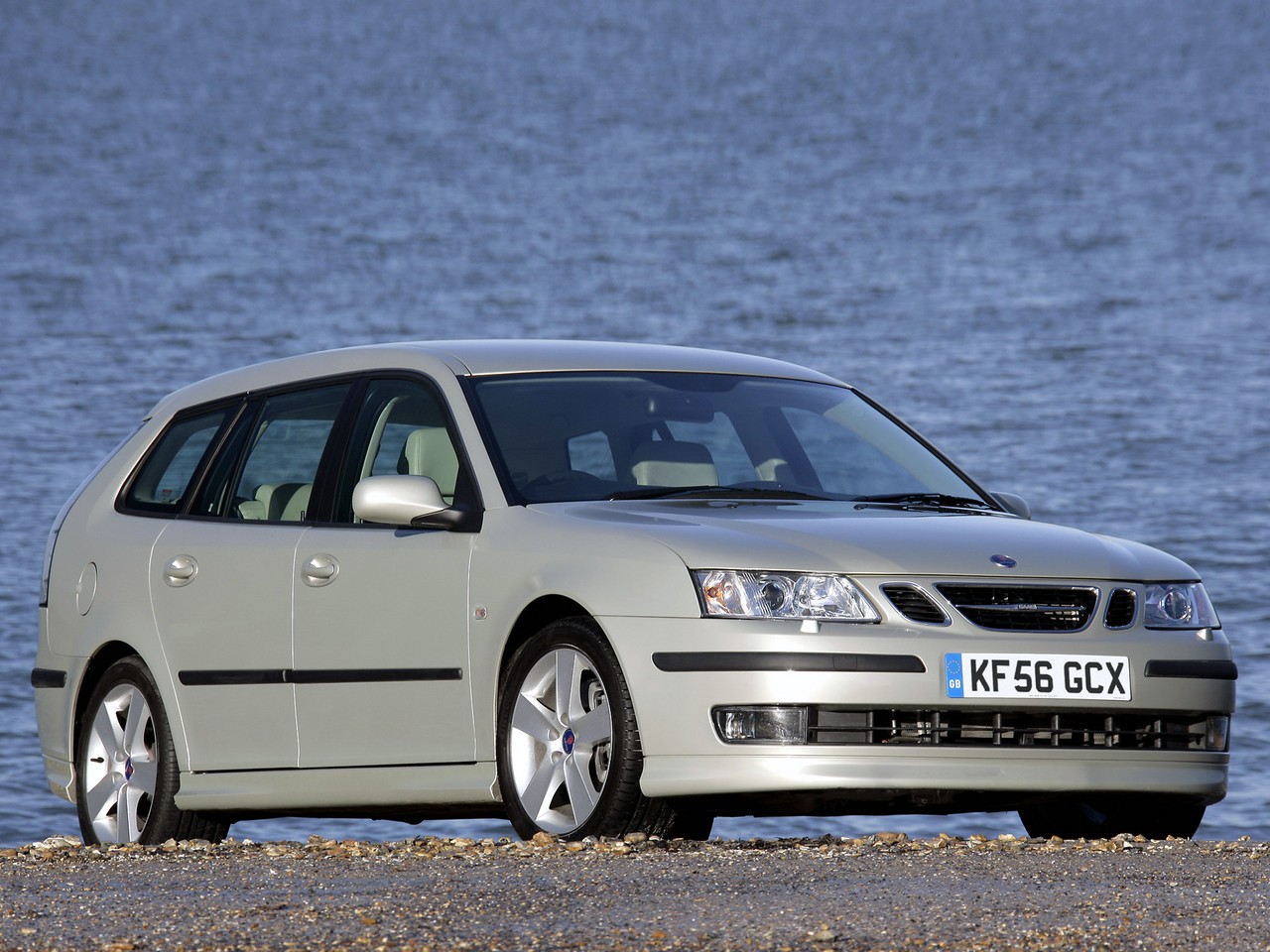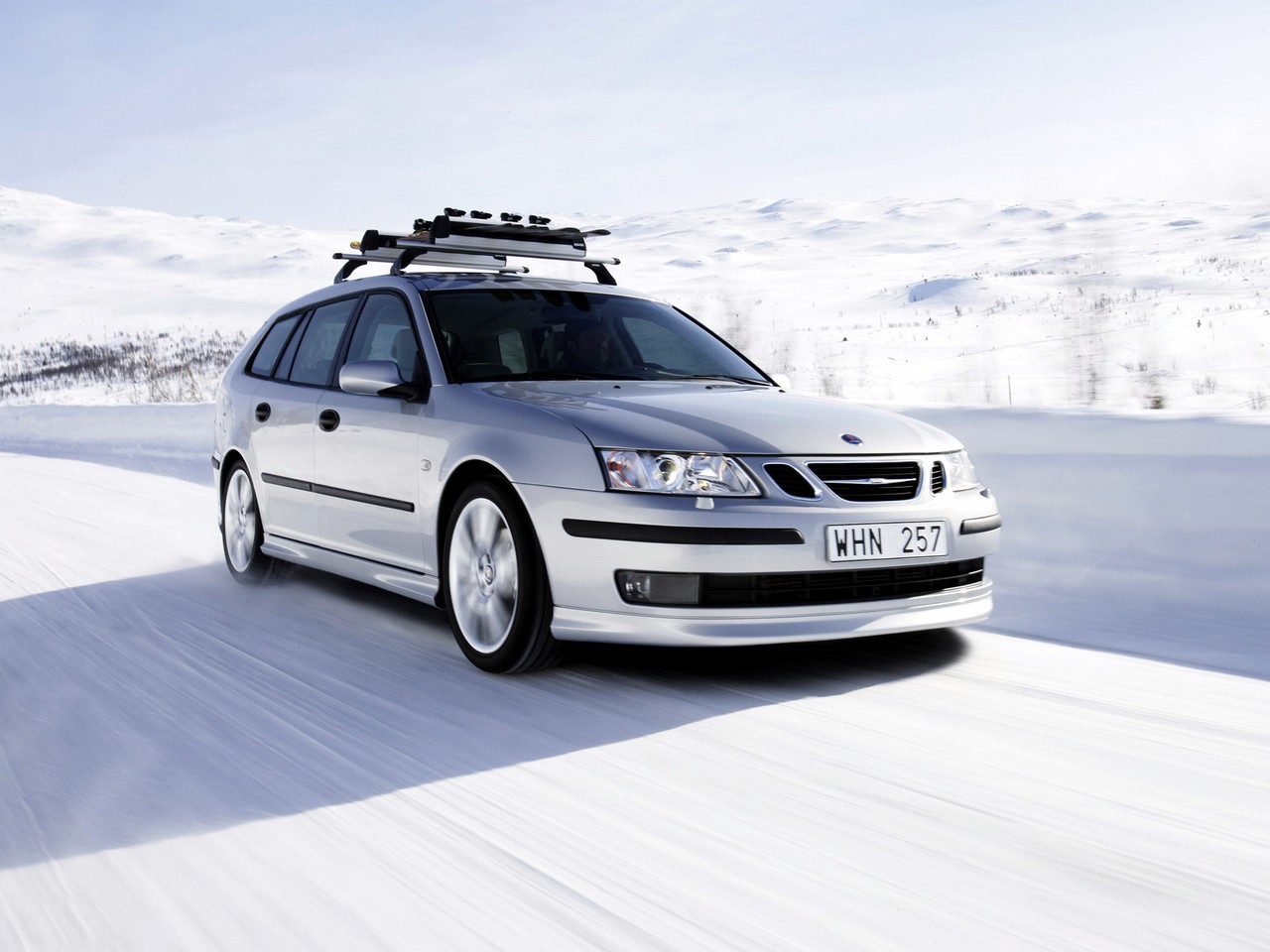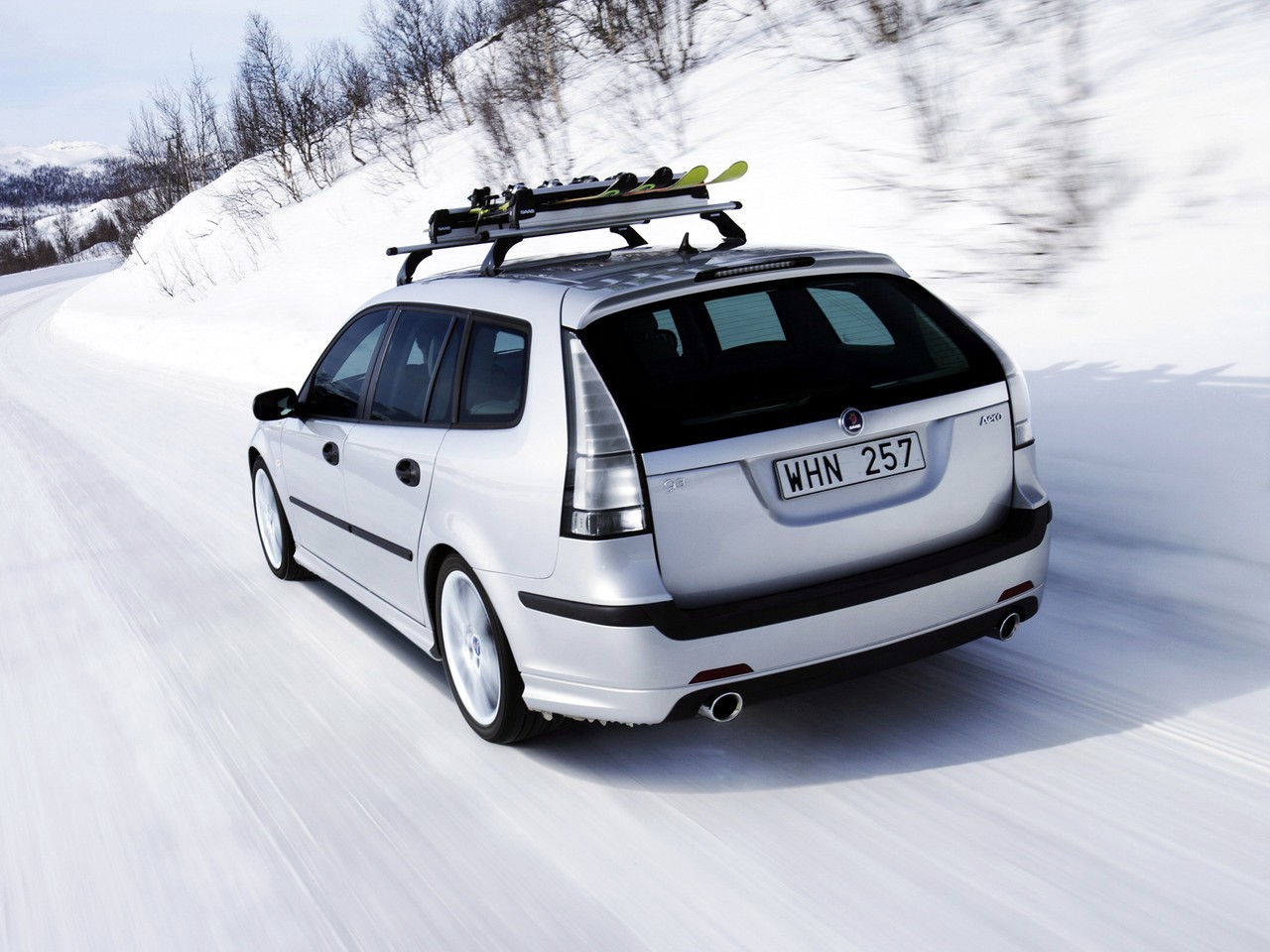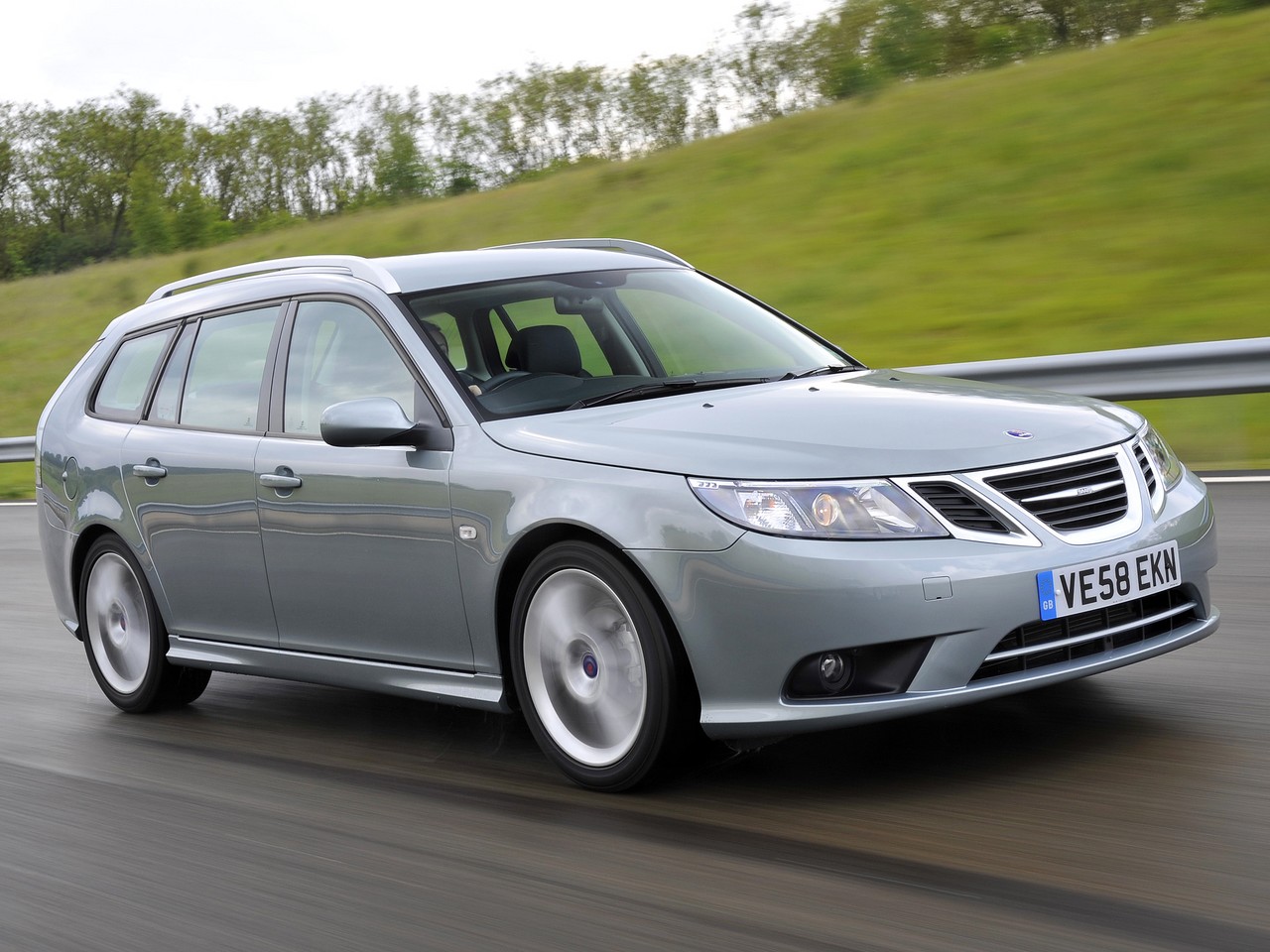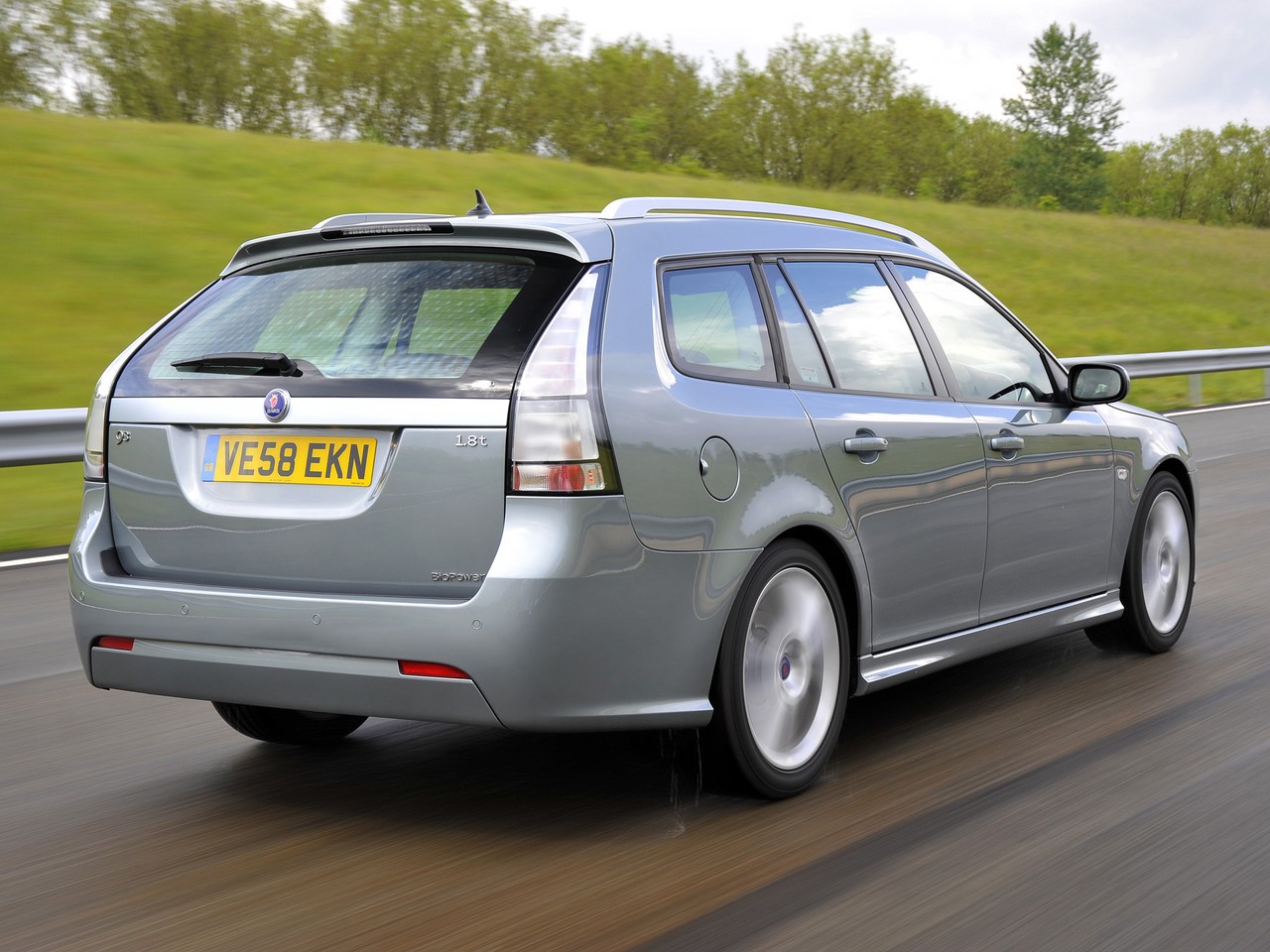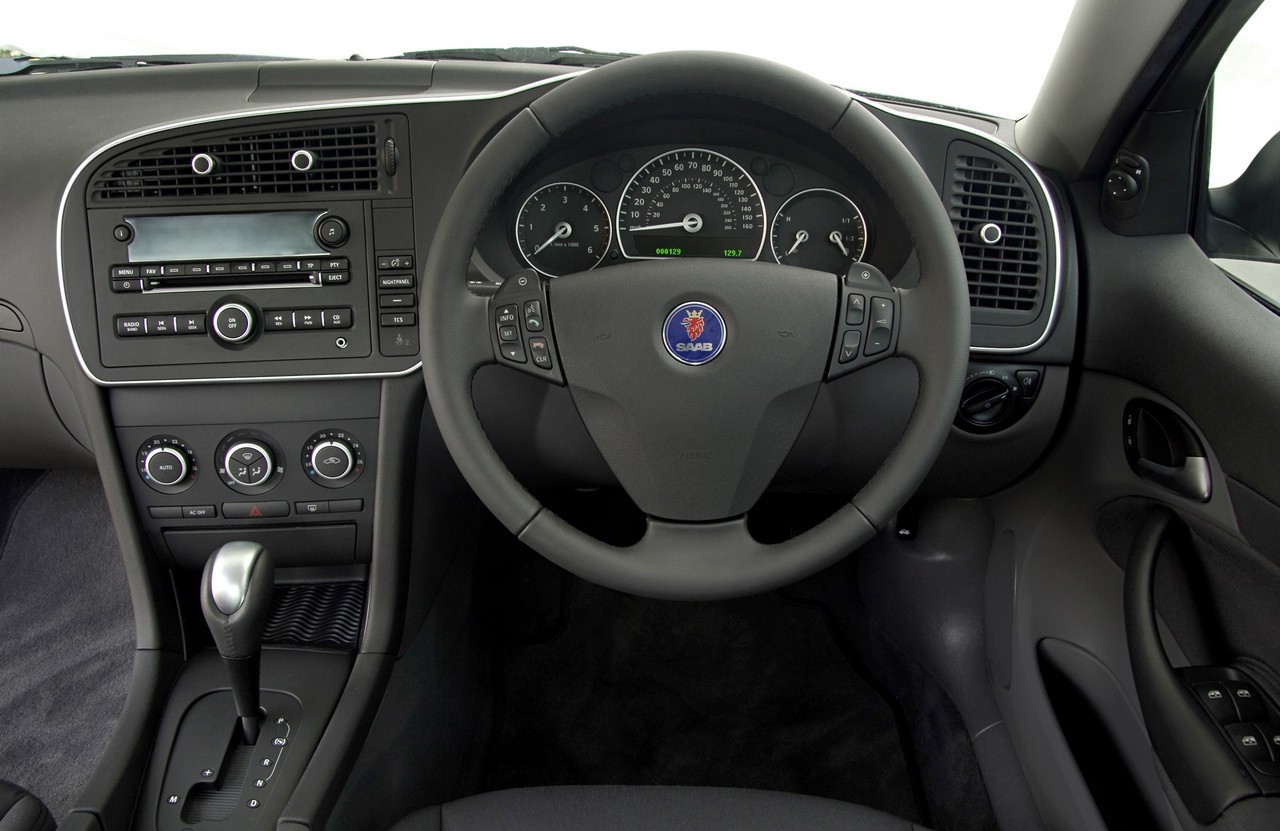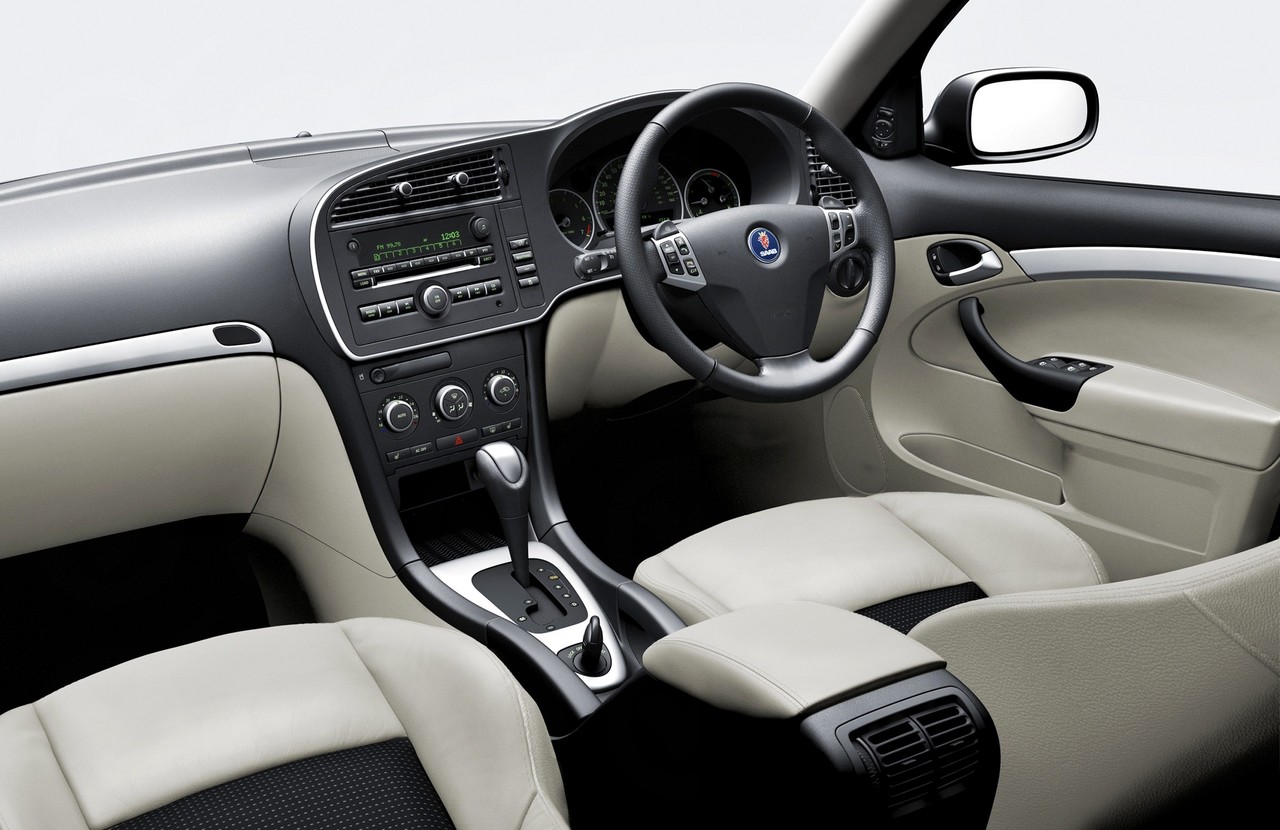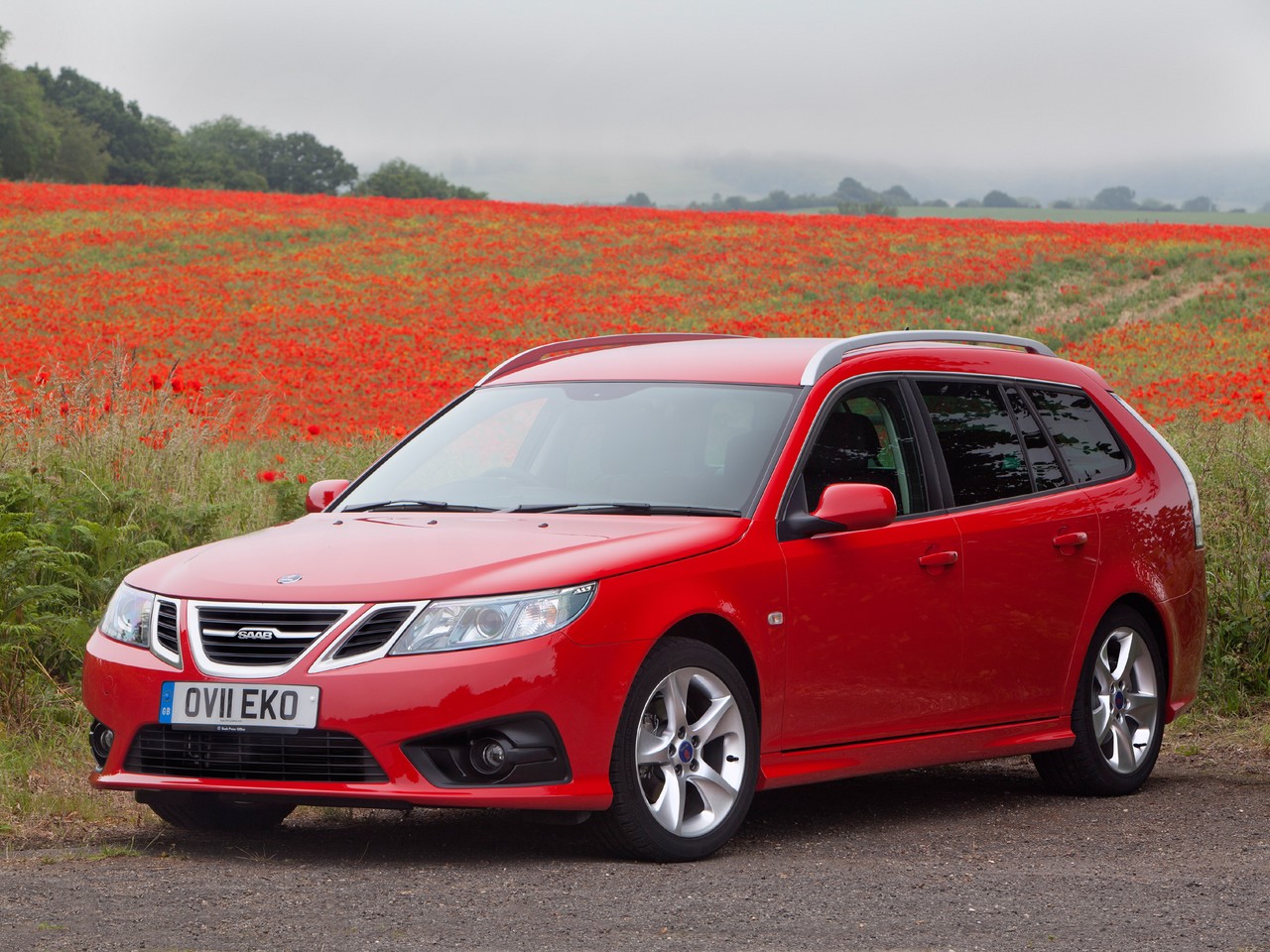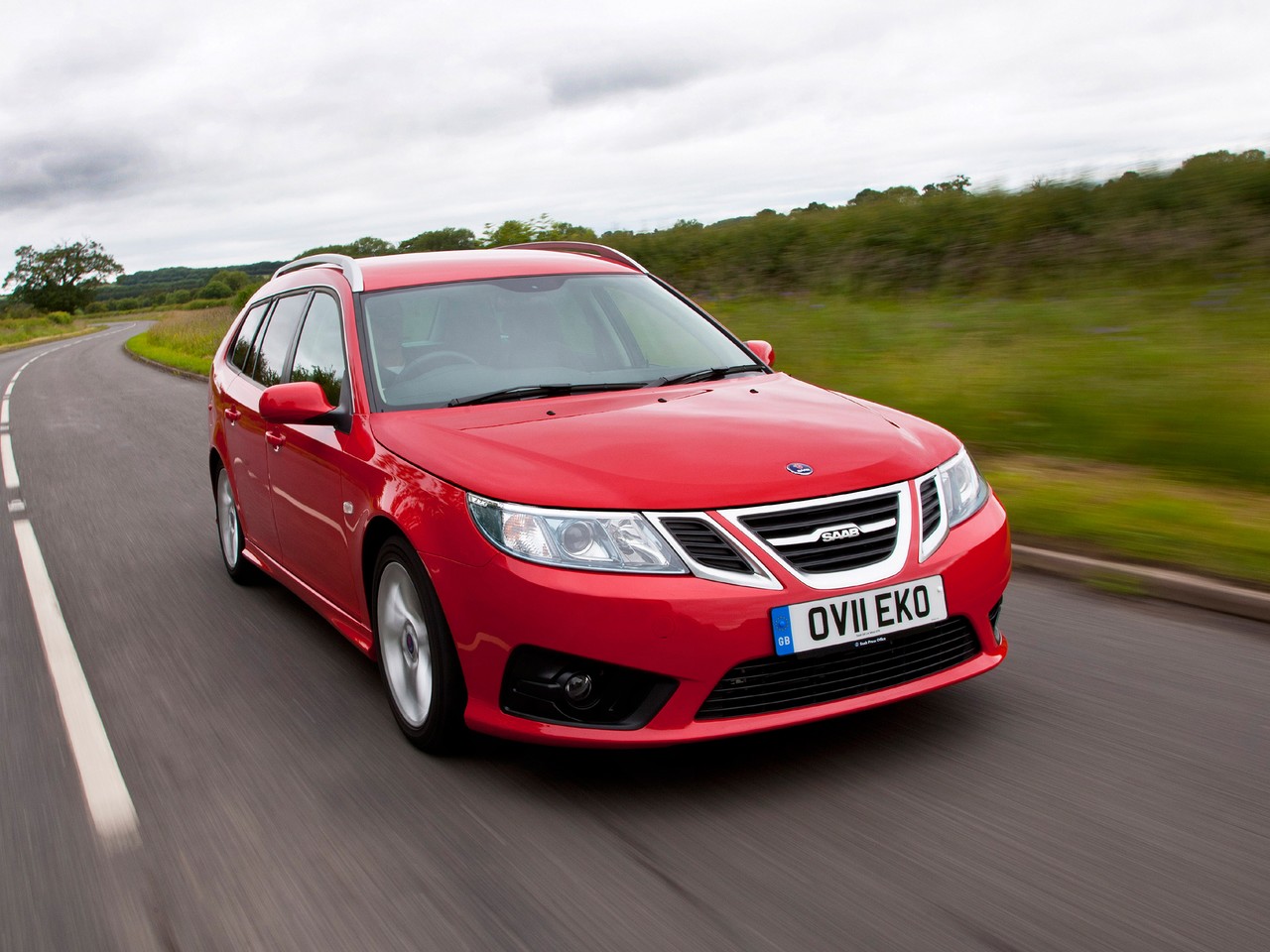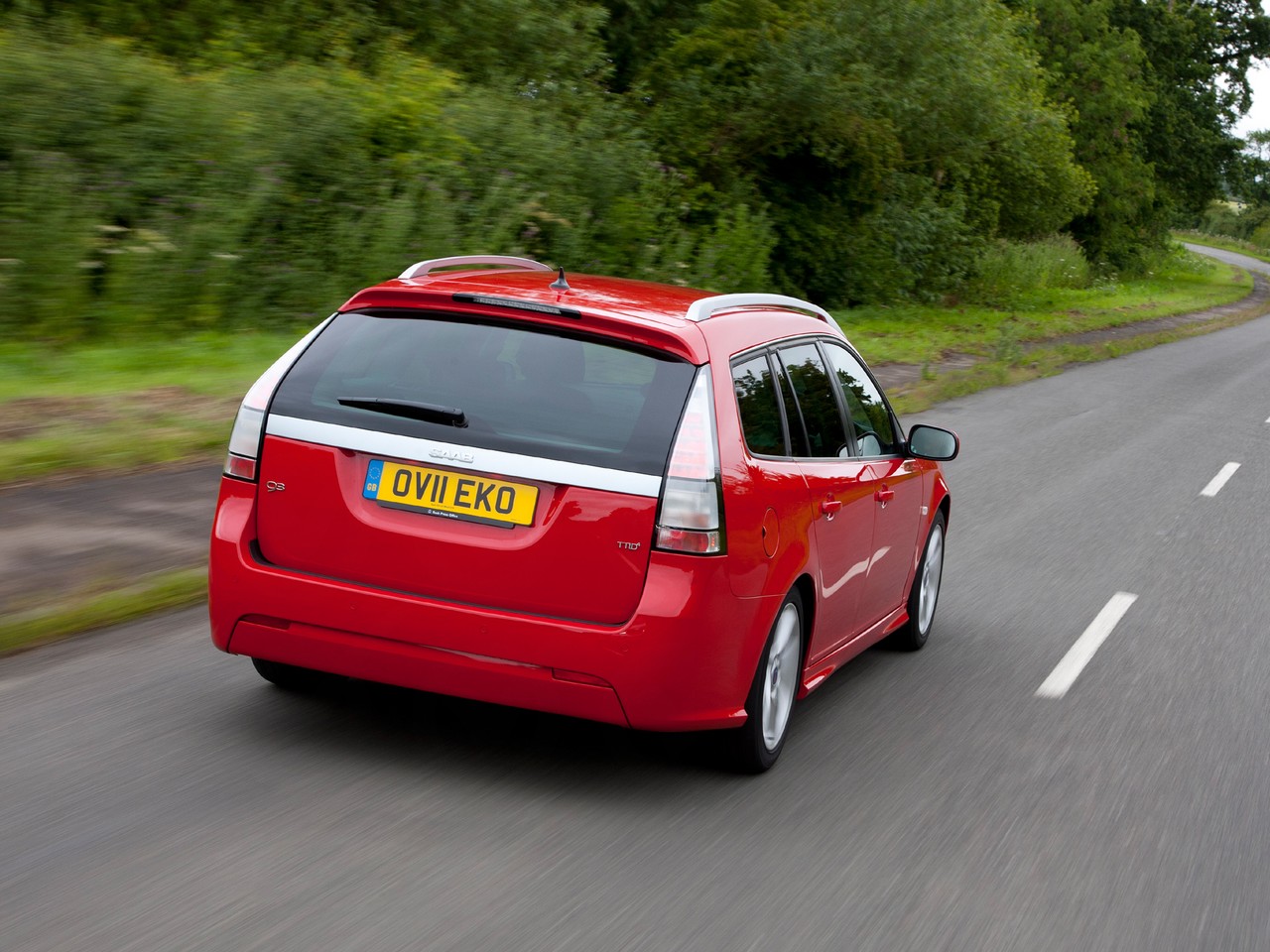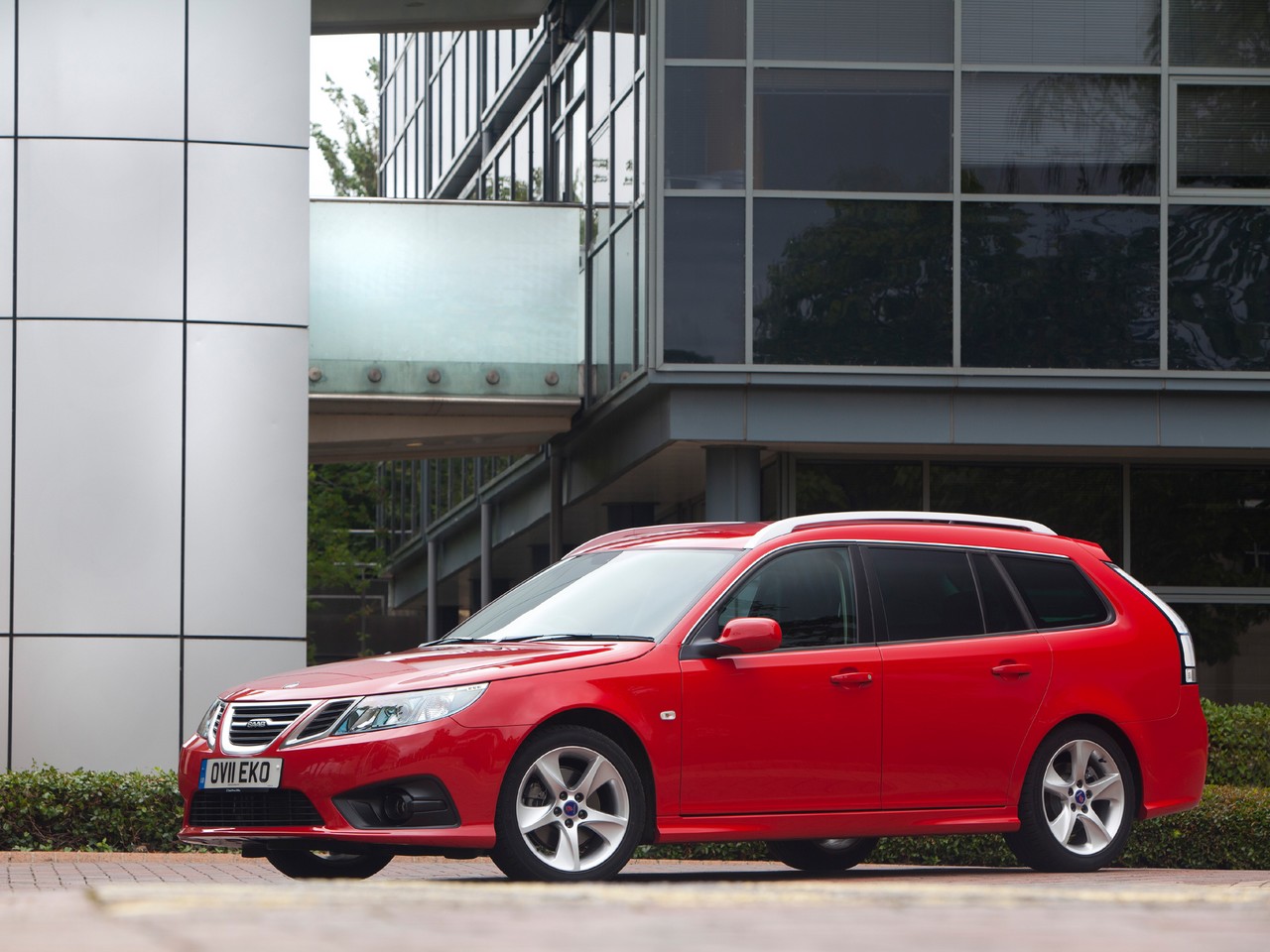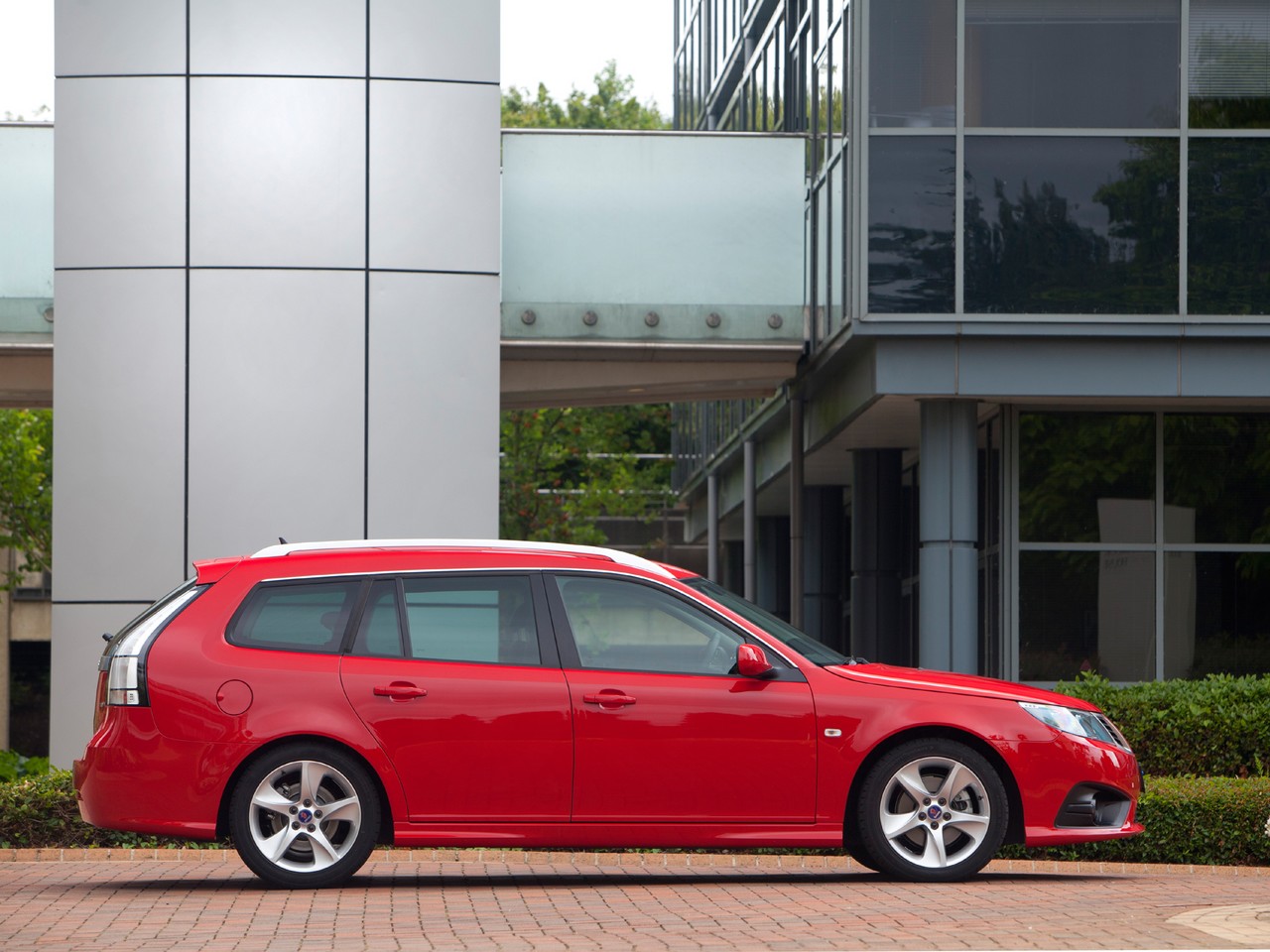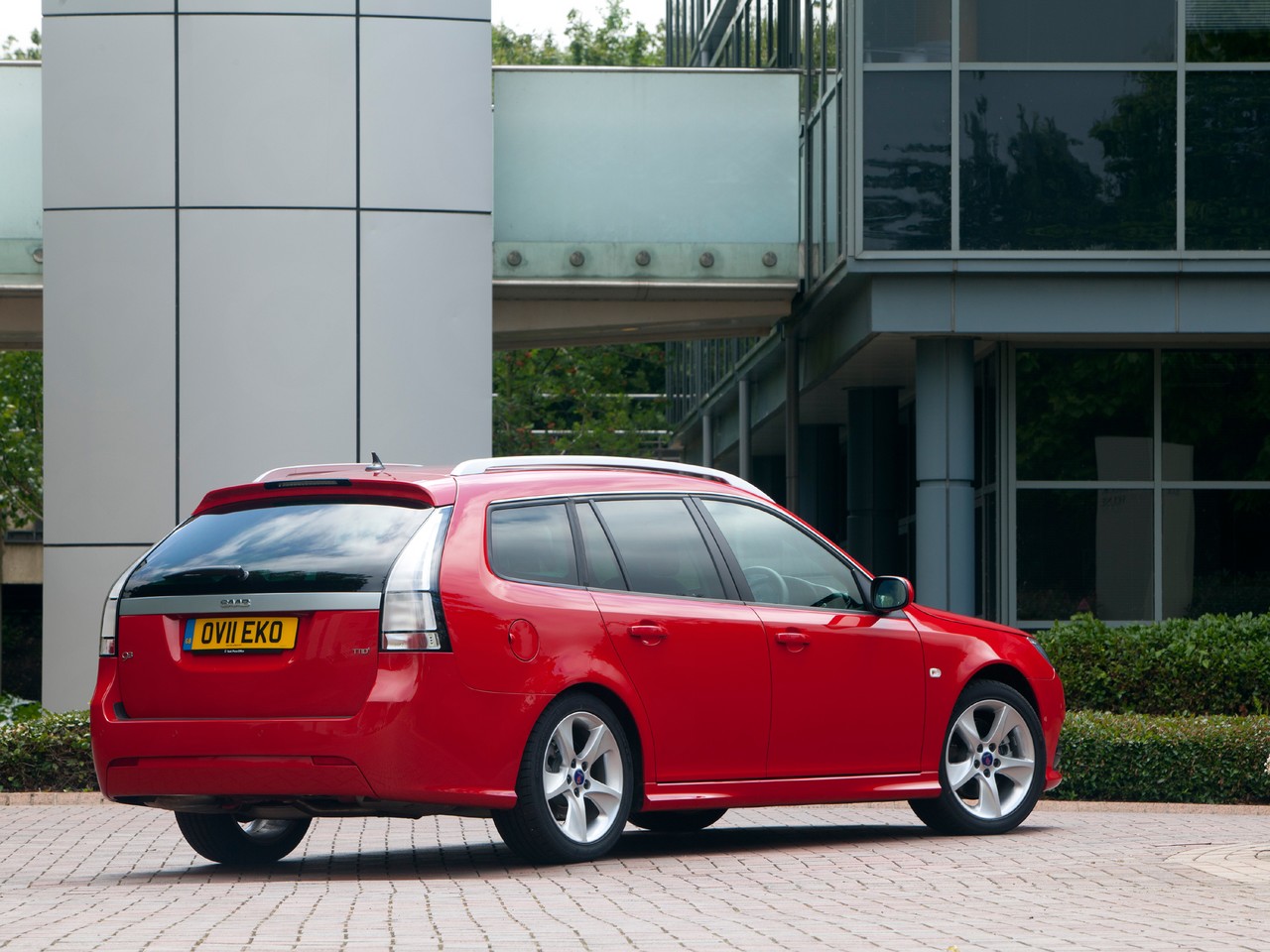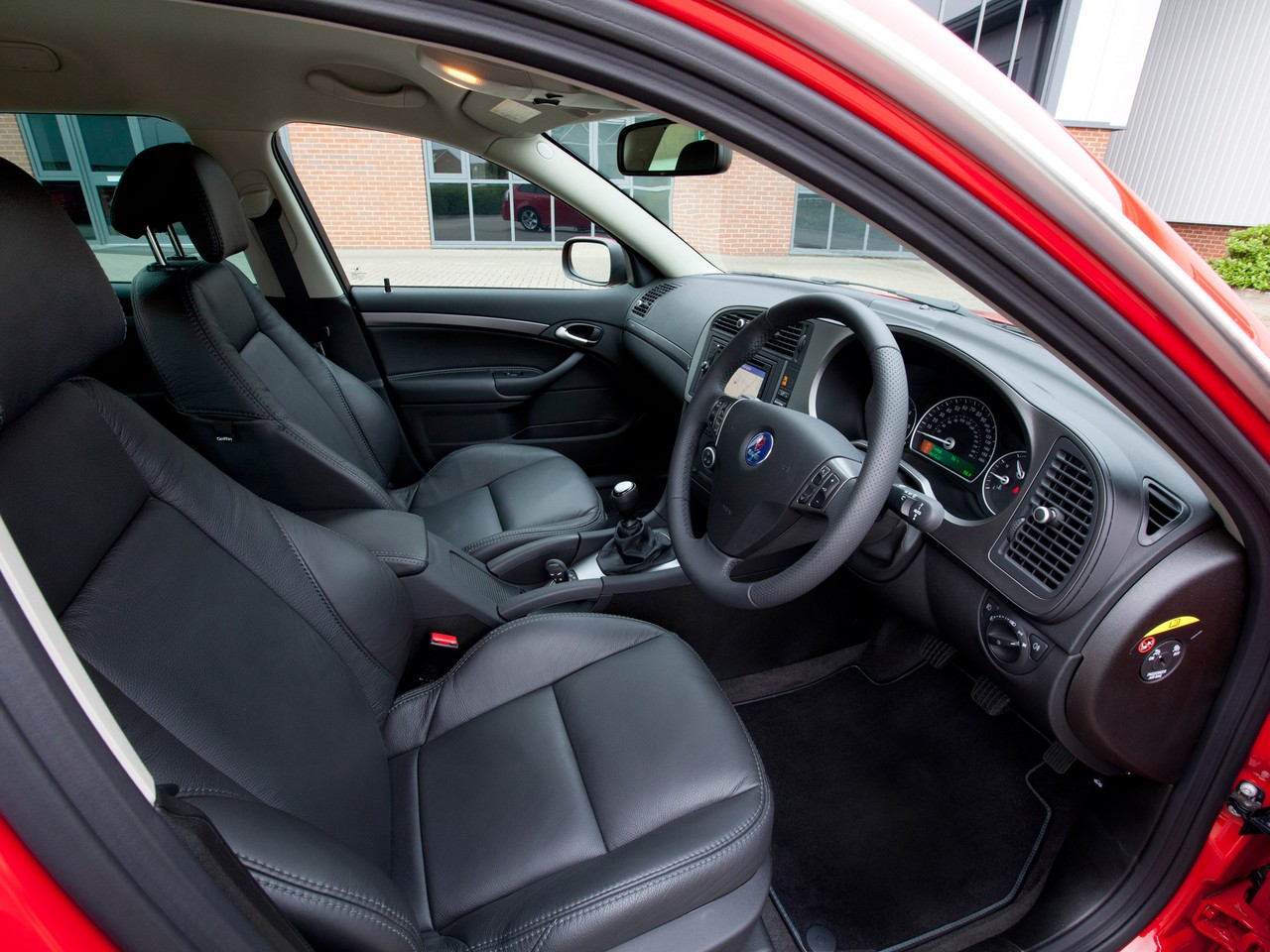
- Flexible low-pressure turbo petrol engines
- Responsive 1.9-litre turbo-diesel engine
- For 9-3 Aero, powerful 2.8-litre turbo V6 engine
- Competent dynamics
- Supportive front seats
- Well-weighted steering
- Suspension lacks compliance on uneven surfaces
- Limited rear seat legroom
- Some cheap interior details
Review: Saab Mk.2-I 9-3 SportCombi (2006-07)
Overview
Released in February 2006, the Saab Mk.2 Series I (Mk.2-I) 9-3 SportCombi was a mid-size wagon (the Mk.2 9-3 sedan has been reviewed separately.) Manufactured in Trollhattan, Sweden, the front-wheel drive 9-3 range initially consisted of three variants – the 1.8t, 2.0t and 2.0T – though all were powered by 2.0-litre turbocharged four-cylinder engines. In 2005, the range was expanded with 2.8-litre turbocharged petrol engines and, in 2007, 1.9-litre turbo-diesel engines.
Engines
Of the engines,
- The 2.0-litre Ecotec LK9 petrol engines which had aluminium blocks and cylinder heads, double overhead camshafts, twin balance shafts, four valves per cylinder and compression ratios of 9.5:1. However,
- For 1.8t variants, the B207E engine had a Garrett GT2052s turbocharger which provided maximum boost pressure of 0.50 bar;
- The 2.0t variants, the B207L also had a Mitsubishi TD04-11TK turbocharger with peak boost pressure of 0.70 bar; and,
- For 2.0T variants, the B207R engine had a more Mitsubishi TD04-14T turbocharger which provided maximum boost pressure of 0.85 bar;
- The 2.8-litre B284L (or LP9) V6 petrol engine had an aluminium alloy block and cylinder head, sequential fuel injection, a Mitsubishi TD04 twin-scroll turbocharger (maximum boost pressure of 0.5 bar), double overhead camshafts, four valves per cylinder (with sodium-filled exhaust valves), variable valve timing, and a compression ratio of 9.5:1; and,
- The 1.9-litre Z19DT turbo-diesel engine had a cast iron block, aluminium alloy cylinder head, common-rail direct injection, a GTA17V Garrett variable geometry turbocharger, double overhead camshafts, four valves per cylinder, exhaust gas recirculation and a compression ratio of 17.5:1.
Body and dimensions
The 9-3 SportCombi was 4635 mm long, 1762 mm wide, 1466 mm tall and had a 2675 mm long wheelbase. With its rear seats in place, the 9-3 SportCombi had cargo capacity of 419 litres, though this increased to 1273 litres with the seats folded down. However, the ‘TwinFloor’ stowage facility enabled the cargo floor to be transversely folded and repositioned for access to a recessed subfloor.
The 9-3 SportCombi body had a drag coefficient of 0.33 Cd, while torsional rigidity was 21,000 Nm/degree.
Suspension
The 9-3 SportCombi had MacPherson strut front suspension and independent, four-link rear suspension with passive rear wheel steering (Saab’s ‘ReAxs’).
| Variant | Editions | Year | Engine | Trans. | Peak power | Peak torque |
|---|---|---|---|---|---|---|
| 1.8t | Linear | 2006-07 | 2.0-litre turbo petrol I4 | 5sp auto, 6sp man. |
110 kW at 5500 rpm | 240 Nm at 2000-3500 rpm |
| 2.0t | Linear, Linear Sport |
2007 | 2.0-litre turbo petrol I4 | 5sp auto, 6sp man. |
129 kW at 5500 rpm | 265 Nm at 2500-4000 rpm |
| 2.0T | Vector, Vector Sport |
2007 | 2.0-litre turbo petrol I4 | 5sp auto, 6sp man. |
154 kW at 5300 rpm | 300 Nm at 2500-4000 rpm |
| 1.9TiD | Linear, Linear Sport |
2007 | 1.9-litre turbo-diesel I4 | 6sp auto, 6sp man. |
110 kW at 4000 rpm | 320 Nm at 2000-2750 rpm |
| 2.8T V6 | Aero | 2006-07 | 2.8-litre turbo petrol V6 | 6sp auto, 6sp man. |
184 kW at 5500 rpm | 350 Nm at 1800-4500 rpm |
Safety equipment
Standard safety equipment for the 9-3 SportCombi included dual front airbags, front side airbags with head and thorax protection, full-length curtain airbags (i.e. for front and rear occupants), ABS, electronic brake force distribution, brake assist, electronic stability control, cornering brake control, traction control, anti-submarining front and rear seats, active front seat head restraints and front and rear seatbelts with pretensioners and load limiters.
Euro NCAP crash testing
In Euro NCAP crash testing , a 2002 Mk.2 9-3 sedan – on which the 9-3 SportCombi was based – received a five star adult occupant protection rating with a score of 33.15 out of 37. Please note, however, that the 9-3 SportCombi’s body structure was marginally less rigid than the sedan. In the frontal offset impact test for the 9-3 sedan, the front occupants’ chests were subject to high forces and a point beneath the steering column posed a risk to the driver’s knees. In the side impact and pole tests, maximum points were awarded. A further two points were awarded for advanced seatbelt reminders.
Features
Standard features for the 9-3 SportCombi Linear included 16-inch wheels, a seven speaker sound system with CD player, 3.5 mm auxiliary input and MP3-compatibility, dual-zone climate control air conditioning, cruise control, leather seats, heated front seats, cooled glove box, rain-sensing wipers, 60/40 split and folding rear seats with ski-port, a leather-wrapped steering wheel with audio controls, remote central locking, power windows and heated mirrors, a height and reach adjustable steering wheel, height adjustable front seats, two 12 volt power outlets, underfloor storage compartments (‘TwinFloor’), cargo cover and immobiliser.
The 9-3 SportCombi Linear Sport was further equipped with 17-inch wheels, a power adjustable driver’s seat, front fog lights and rear parking sensors. Beyond this, the 9-3 SportCombi Vector added a six-disc in-dash CD player, footwell lights and floor mats.
Compared to the Vector, the 9-3 SportCombi Vector Sport was equipped with sports suspension, driver’s seat memory settings and a power-operated sunroof (which was unique to Vector Sport). The Aero was distinguished by its power adjustable front passenger seat and chrome exterior highlights.
2007: 9-3 SportCombi update
The 9-3 SportCombi was updated for 2007 with a new front fascia, instrument display and switchgear. Furthermore, Bluetooth connectivity was made standard across the range, while there were also new paint colours, revised suspension settings and improved sound insulation.
Review: Saab Mk.2-II 9-3 SportCombi (2007-10)
Overview
Released in November 2007, the Mk.2 Series II (Mk.2-II) 9-3 SportCombi introduced revised styling and E85 compatible engines for the 2.0t BioPower variant. In May 2008, the range was further expanded with the introduction of a 1.9-litre twin-turbo diesel engine (1.9TTiD).
Visually, the Mk.2-II 9-3 SportCombi could be identified by its more aggressive appearance with a larger grille and headlights, reshaped bumpers, daytime running lights and flared side sill extensions.
Z9DTH engine
Compared to the 1.9-litre Z19DT turbo-diesel engine, the Z9DTH twin-turbo diesel engines had two sequential BorgWarner R2S turbochargers (with maximum boost pressure of 1.8 bar) and a lower compression ratio (16.5:1 compared to 17.5:1). From idle to 1500 rpm, exhaust gases were solely directed to the smaller turbocharger. From 1500 rpm to 3000 rpm, exhaust gases were split between the turbines, providing greater boost pressure. From 3000 rpm, only the larger turbocharger was engaged.
| Variant | Editions | Year | Engine | Trans. | Peak power | Peak torque |
|---|---|---|---|---|---|---|
| 2.0t | Linear, Vector |
2007-08 | 2.0-litre turbo petrol I4 | 5sp auto, 6sp man. |
129 kW at 5500 rpm | 265 Nm at 2500-4000 rpm |
| Vector | 2009 | 5sp auto | ||||
| 2.0t BioPower | Linear, Vector |
2007-10 | 2.0-litre turbo petrol I4 | 5sp auto, 6sp man. |
147 kW at 5500 rpm | 300 Nm at 2500-4000 rpm |
| 2.0T | Vector | 2007-10 | 2.0-litre turbo petrol I4 | 5sp auto, 6sp man. |
154 kW at 5300 rpm | 300 Nm at 2500-4000 rpm |
| 1.9TiD | Linear, Vector |
2007-10 | 1.9-litre turbo-diesel I4 | 6sp auto, 6sp man. |
110 kW at 4000 rpm | 320 Nm at 2000-2750 rpm |
| 1.9TTiD | Aero | 2008-10 | 1.9-litre twin turbo-diesel I4 | 6sp auto, 6sp man. |
132 kW at 4000 rpm | 400 Nm at 1850-2750 rpm |
| 2.8T V6 | Aero | 2007-10 | 2.8-litre turbo petrol V6 | 6sp auto, 6sp man. |
188 kW at 5500 rpm | 350 Nm at 1800-4500 rpm |
| Turbo X | 2008 | 2.8-litre turbo petrol V6 | 6sp auto, 6sp man. |
206 kW at 5500 rpm | 400 Nm at 2150-4500 rpm |
Features
Compared to its Mk.2-I predecessor, standard features for the Aero edition were extended to include bi-xenon headlights and power folding mirrors.
2008 Saab 9-3 SportCombi Turbo X
Released in June 2008, the Turbo X was fitted with a more powerful 2.8-litre turbocharged V6 petrol engine than the Aero (maximum boost pressure increased from 05 to 0.8 bar), 10mm lower suspension, stiffer springs and dampers, self-levelling rear dampers and an ‘XWD’ all-wheel drive system (see below). Compared to the Aero, the Turbo X was distinguished by its 18-inch alloy wheels with 235/45 R18 tyres, black leather sports seats, ‘carbon-look’ interior trim and a Jet Black metallic paint finish.
The Turbo X was also fitted with an upgraded braking package consisting of 345mm by 30mm internally ventilated front discs and 292mm by 20mm externally ventilated rear discs.
In normal conditions, the XWD system provided a 90:10 front/rear torque split, but the pre-tensioned clutch could provide a 50:50 front/rear torque split if a loss of traction was anticipated. Furthermore, the XWD system included an electronically-controlled limited slip rear differential which could transfer up to 40 per cent of torque between the drive shafts to whichever rear wheel had more grip in order to provide a yaw damping effect.
Cessation of imports
Imports of the 9-3 were discontinued in June 2010 following General Motor’s sale of Saab to Spyker.
Review: Saab Mk.2-III 9-3 SportCombi (2011)
Overview
As part of Saab’s short-lived return to Australia, the Mk.2 Series III (Mk.2-III) 9-3 SportCombi was released in March 2011. The Mk.2-III 9-3 SportCombi range consisted of two variants, the 2.0t BioPower and 2.0TS, offered in Linear and Aero editions respectively.
| Variant | Edition | Engine | Trans. | Peak power | Peak torque |
|---|---|---|---|---|---|
| 2.0t BioPower | Linear | 2.0-litre turbo petrol I4 | 5sp auto | 147 kW at 5500 rpm | 300 Nm at 2500-4000 rpm |
| 1.9TTid | Aero | 1.9-litre twin turbo-diesel I4 | 6sp auto | 132 kW at 4000 rpm | 400 Nm at 1850-2750 rpm |
Features
Standard features for the 9-3 SportCombi Linear included 16-inch alloy wheels, seven speaker sound system with CD player and MP3 compatibility, dual-zone climate control air conditioning, leather seats, heated front seats, cruise control, rear fog lamps, rain-sensing wipers, multi-function steering wheel with gearshift buttons, remote central locking, power windows and heated mirrors, a height and reach adjustable steering wheel, 12 volt power outlet, trip computer and an immobiliser.
Beyond this, the 9-3 SportCombi Aero added 17-inch alloy wheels with sports suspension and upgraded brakes, ten speaker sound system with six-disc CD player, power adjustable front seats with driver’s seat memory settings, bi-xenon headlights, rear parking sensors, front fog lamps and alarm.
Related links
